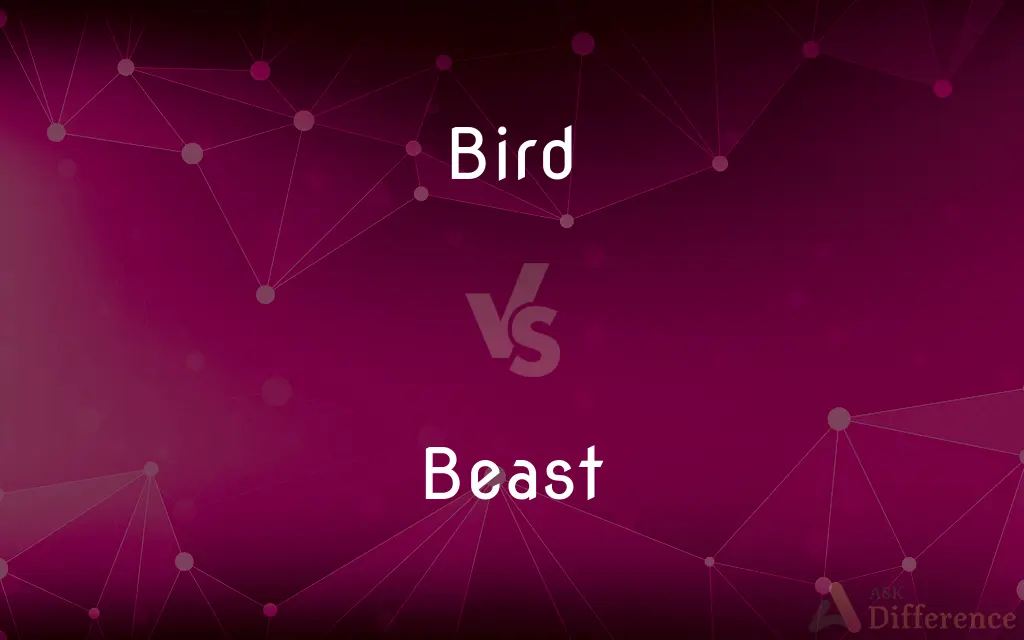Bird vs. Beast — What's the Difference?
By Tayyaba Rehman & Fiza Rafique — Updated on April 1, 2024
Birds are feathered, winged animals capable of flight, belonging to the class Aves, while beasts traditionally refer to large and often wild four-legged mammals.

Difference Between Bird and Beast
Table of Contents
ADVERTISEMENT
Key Differences
Birds, members of the class Aves, are characterized by their feathers, beak with no teeth, the laying of hard-shelled eggs, a high metabolic rate, and a lightweight but strong skeleton. They are unique in their ability to fly, although not all birds are capable of flight. On the other hand, the term "beast" is often used to describe large, four-legged mammals, especially those that are wild or perceived as dangerous. This term is not scientifically precise and can vary in context, including mythical creatures or as a colloquial term for animals considered to be formidable or majestic.
Birds are found in almost every habitat on Earth, from dense forests to open oceans, and have evolved various adaptations for flight, such as wings and hollow bones. Beasts, as broadly defined, occupy diverse habitats as well, from the savannas where elephants roam to the dense forests inhabited by bears. The diversity within the avian world is immense, with over 10,000 known species, showcasing a wide range of sizes, colors, and behaviors. Beasts, depending on the specific animals considered under this category, also display a significant diversity, particularly in terms of size, diet, and habitat.
The reproductive strategies of birds include building nests and laying eggs, with both parents often involved in raising the young. Beasts, particularly mammals, give birth to live young and have various reproductive strategies, including the care of offspring by one or both parents. Birds communicate through vocalizations and visual signals, and many species are known for their complex songs and calls. Beasts, especially mammals, use a range of communication methods, including vocal sounds, body language, and, in some cases, chemical signals.
Conservation efforts for birds focus on protecting habitats, preventing hunting, and addressing threats like climate change. Conservation of beasts, particularly large mammals, often involves habitat preservation, anti-poaching measures, and efforts to mitigate human-wildlife conflicts. While "bird" has a clear scientific classification, "beast" is more fluid, encompassing a wide range of animals across various contexts and cultures, often reflecting human perceptions of animality and wilderness.
Comparison Chart
Lassification
Class Aves
Broad, informal term for large mammals
ADVERTISEMENT
Characteristics
Feathers, wings, beak, lay eggs
Large, four-legged, often wild or domesticated
Ability
Many capable of flight
Primarily terrestrial, some aquatic
Reproduction
Lay hard-shelled eggs
Mostly live birth
Communication
Vocalizations, visual signals
Vocal sounds, body language, chemical signals
Conservation
Habitat protection, anti-hunting, climate change mitigation
Habitat preservation, anti-poaching, human-wildlife conflict mitigation
Compare with Definitions
Bird
Use songs and calls to communicate.
The song of the nightingale is often heard during the mating season.
Beast
Capable of a range of communications.
The howl of a wolf, a beast known for its social structure, can communicate across long distances.
Bird
Feathered, winged vertebrates, most capable of flight.
The eagle soared above, a magnificent example of a bird at its most majestic.
Beast
An informal term referring to large, often wild animals.
The lion, often called the king of beasts, roams the African savannah.
Bird
Lay hard-shelled eggs and often build nests.
Robins are known for their blue eggs and carefully constructed nests.
Beast
Four-legged mammals, including those in myths.
Myths often speak of beasts with incredible strength or magical powers.
Bird
Species within the class Aves, characterized by feathers and beak.
The hummingbird is one of the smallest birds, known for its rapid wing beats.
Beast
Occupy diverse habitats across the globe.
The Amazon rainforest is home to beasts like the jaguar, the top predator of its ecosystem.
Bird
Found in diverse habitats worldwide.
Penguins are birds adapted to life in icy Antarctic waters.
Beast
Subject of various conservation efforts.
Elephants, gentle giants of the wild, are beasts that require extensive conservation measures.
Bird
A person of a specified kind or character
She's a sharp old bird
Beast
An animal, especially a large or dangerous four-footed one
A wild beast
Bird
A young woman or a girlfriend.
Beast
An animal other than a human, especially a large four-footed mammal.
Bird
Such an animal hunted as game.
Beast
Animal nature as opposed to intellect or spirit
An insult that brought out the beast in him.
Bird
Such an animal, especially a chicken or turkey, used as food
Put the bird in the oven.
Beast
A very large or powerful person or thing
Drives a beast of a truck.
Bird
See clay pigeon.
Beast
Something of a specified kind
Her latest film is an odd beast.
Bird
(Sports) See shuttlecock.
Beast
A brutal, contemptible person.
Bird
(Slang) A rocket, guided missile, satellite, or airplane.
Beast
Any animal other than a human; usually only applied to land vertebrates, especially large or dangerous four-footed ones.
Bird
(Slang) A person, especially one who is odd or remarkable
A sly old bird.
Beast
A domestic animal, especially a bovine farm animal.
Bird
Chiefly British Slang A young woman.
Beast
A monstrously unusual and dangerous animal.
Bird
A loud sound expressing disapproval; a raspberry.
Beast
A person who behaves in a violent, antisocial or uncivilized manner.
Bird
Discharge from employment
Lost a big sale and nearly got the bird.
Beast
(slang) Anything regarded as larger or more powerful than one of its normal size or strength.
That is a beast of a stadium.
The subwoofer that comes with this set of speakers is a beast.
Bird
An obscene gesture of anger, defiance, or derision made by pointing or jabbing the middle finger upward.
Beast
(slang) Someone who is particularly impressive, especially athletically or physically.
Bird
To observe and identify birds in their natural surroundings.
Beast
(figuratively) Something unpleasant and difficult.
Bird
To trap, shoot, or catch birds.
Beast
A thing or matter, especially a difficult or unruly one.
Bird
A chicken or turkey used as food.
Pitch in and help me stuff the bird if you want Thanksgiving dinner.
Beast
To impose arduous exercises, either as training or as punishment.
Bird
(slang) A man, fellow.
Beast
Great; excellent; powerful
Bird
A girlfriend.
Mike went out with his bird last night.
Beast
Any living creature; an animal; - including man, insects, etc.
Bird
(slang) An airplane.
Beast
Any four-footed animal, that may be used for labor, food, or sport; as, a beast of burden.
A righteous man regardeth the life of his beast.
Bird
(slang) A satellite.
Beast
Any animal other than a human; - opposed to man.
'Tain't a fit night out for man nor beast.
Bird
(obsolete) A chicken; the young of a fowl; a young eaglet; a nestling.
Beast
Fig.: A coarse, brutal, filthy, or degraded fellow.
Bird
Booing and jeering, especially as done by an audience expressing displeasure at a performer.
Beast
A game at cards similar to loo.
Bird
(with definite article) The vulgar hand gesture in which the middle finger is extended.
Beast
A penalty at beast, omber, etc. Hence: To be beasted, to be beaten at beast, omber, etc.
Bird
A yardbird.
Beast
A living organism characterized by voluntary movement
Bird
A kilogram of cocaine.
Beast
A cruelly rapacious person
Bird
A penis.
Bird
(slang) A prison sentence.
He’s doing bird.
Bird
(intransitive) To observe or identify wild birds in their natural environment.
Bird
(intransitive) To catch or shoot birds; to hunt birds.
Bird
To seek for game or plunder; to thieve.
Bird
To transmit via satellite.
Bird
To bring into prison, to roof.
Bird
Able to be passed with very little work; having the nature of a bird course.
Bird
Orig., a chicken; the young of a fowl; a young eaglet; a nestling; and hence, a feathered flying animal (see 2).
That ungentle gull, the cuckoo's bird.
The brydds [birds] of the aier have nestes.
Bird
Specifically, among sportsmen, a game bird.
Bird
Fig.: A girl; a maiden.
And by my word! the bonny birdIn danger shall not tarry.
Bird
To catch or shoot birds.
Bird
Hence: To seek for game or plunder; to thieve.
Bird
To watch birds, especially in their natural habitats, for enjoyment; to birdwatch.
Bird
The flesh of a bird or fowl (wild or domestic) used as food
Bird
Informal terms for a (young) woman
Bird
A cry or noise made to express displeasure or contempt
Bird
Badminton equipment consisting of a ball of cork or rubber with a crown of feathers
Bird
Watch and study birds in their natural habitat
Common Curiosities
How do birds and beasts contribute to their ecosystems?
Both play vital roles in their ecosystems, such as pollination, seed dispersal, controlling pest populations, and as part of the food chain.
Can birds be considered beasts?
In casual speech, some might refer to large or powerful birds as beasts, but scientifically, birds are not classified as beasts.
Why are conservation efforts important for both birds and beasts?
Conservation is crucial for protecting biodiversity, maintaining ecosystems, and ensuring the survival of species facing threats from habitat loss, climate change, and human activities.
Are there any beasts that can fly?
While some mammals like bats can fly, they are not typically referred to as beasts in the traditional sense, which more commonly describes large, terrestrial mammals.
How do humans impact the survival of birds and beasts?
Humans impact their survival through habitat destruction, pollution, climate change, hunting, and introducing invasive species that compete for resources.
Are all beasts considered dangerous?
Not all beasts are dangerous; the term can refer to any large mammal, though it often connotes wildness or strength.
What makes a bird different from other animals?
Birds are unique for their feathers, ability to lay hard-shelled eggs, and, in many cases, the ability to fly.
What challenges do birds face that beasts do not?
Birds face specific challenges like window strikes, being caught by domestic cats, and habitat loss due to deforestation affecting their nesting and feeding sites.
What is the largest bird and the largest beast?
The largest bird is the ostrich, known for its size and speed on land, while the largest land beast is the African elephant, noted for its massive size and strength.
Can domesticated animals be considered beasts?
While domesticated animals can technically be considered beasts, the term is more often used to describe wild animals.
Share Your Discovery

Previous Comparison
Sulphite vs. Sulfite
Next Comparison
Canaan vs. IsraelAuthor Spotlight
Written by
Tayyaba RehmanTayyaba Rehman is a distinguished writer, currently serving as a primary contributor to askdifference.com. As a researcher in semantics and etymology, Tayyaba's passion for the complexity of languages and their distinctions has found a perfect home on the platform. Tayyaba delves into the intricacies of language, distinguishing between commonly confused words and phrases, thereby providing clarity for readers worldwide.
Co-written by
Fiza RafiqueFiza Rafique is a skilled content writer at AskDifference.com, where she meticulously refines and enhances written pieces. Drawing from her vast editorial expertise, Fiza ensures clarity, accuracy, and precision in every article. Passionate about language, she continually seeks to elevate the quality of content for readers worldwide.
















































